
Universidade Fernando Pessoa
Porto, Portugal

Seismic-Sequential Stratigraphy
A downlap is a discordant geometric configuration, in which initially inclined strata terminate downdip against an initially horizontal or inclined surface. Several different kinds of downlap can be considered:
a) Distal downlap
b) False downlap
c) Shelf downlap
d) Basin downlap
e) Opposite (local) downlap
f) Apparent downlap

Plate 168 - On this photograph, it is easy to recognize that a calcareous inclined strata (Unit I) terminates on much less inclined strata (Unit II). This geometrical relationship is called downlap. Therefore, one can say that a downlap surface, characterized by stratal, or seismic reflection terminations, exits between Unit I and II. Downlap surfaces are not unconformities (erosional surfaces), since they correspond mainly to a non-depositional time-gap. However, in the deep parts of a basin, downlap surfaces associated with the downdip terminations of the continental slope progradations can correspond with paraconformities, which are correlable updip with unconformities. In other words, in deep water environments, downlap surfaces can coincide with surfaces bounding stratigraphic cycles.
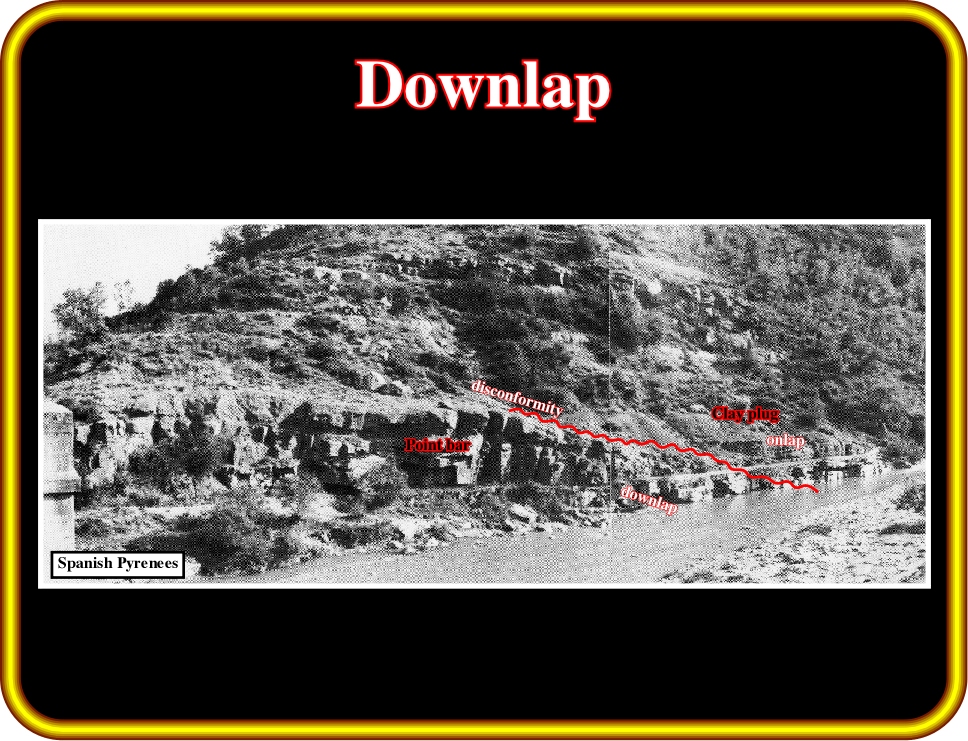
Plate 169 - Downlap geometric relationships exist also in non-marine sediments, particularly in fluvial environments, as illustrated here by the point bar. Indeed, the inclined strata of the point bar terminate downdip against a fluvial erosional surface (not visible). A local disconformity (in red), created probably by a neck-cutoff of the stream, was fossilized by a clay plug. The shales of the clay-plug are onlapping the disconformity limiting the point-bar. In this kind of environment, in which erosion and deposition are synchronous, the term disconformity fits better than unconformity to label the observed sedimentary hiatus.

Plate 170 - On this line, downlap geometrical relationships are paramount on the progradational units. Indeed, seaward inclined seismic reflections (chronostratigraphic lines) terminate against subhorizontal strata. Taking into account the vertical (t.w.t.) and horizontal scales, the pristine inclined reflections correspond to continental slopes. Therefore, one can say, they express roughly the direction away from the source for clastic supply. Briefly speaking, downlaps indicate the seaward direction.
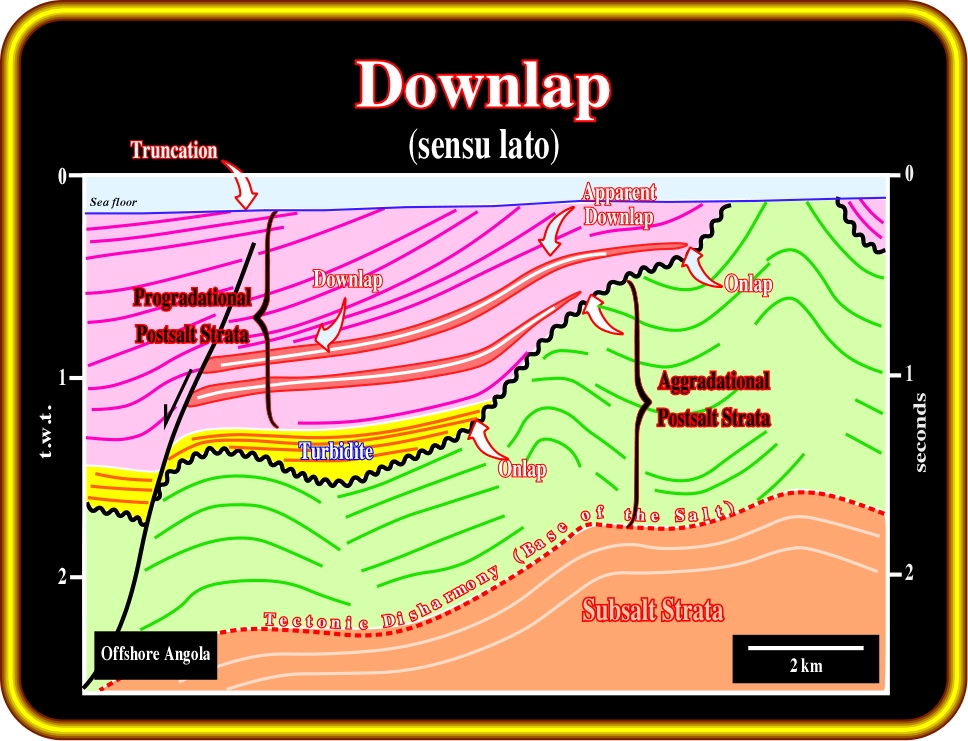
Plate 171 - 0n this line from offshore Angola, three principal sedimentary packages are recognized: (i) subsalt, (ii) aggradational and (iii) progradational postsalt strata. In the upper package, several types of reflection terminations can be identified. Onlaps are associated with the turbidite unit (onlap against the major unconformity). Downlaps are associated with the downdip terminations of some progradational reflections, while onlaps characterize the updip terminations. Two apparent downlaps (see later), with downdip tangential terminations (in brown), as well as truncations along the uppermost unconformity (sea floor), are also easily perceived.
(i) Distal Downlap
A distal downlap is a downlap in the direction away from the source of clastic supply. The majority of downlaps are distal downlaps.
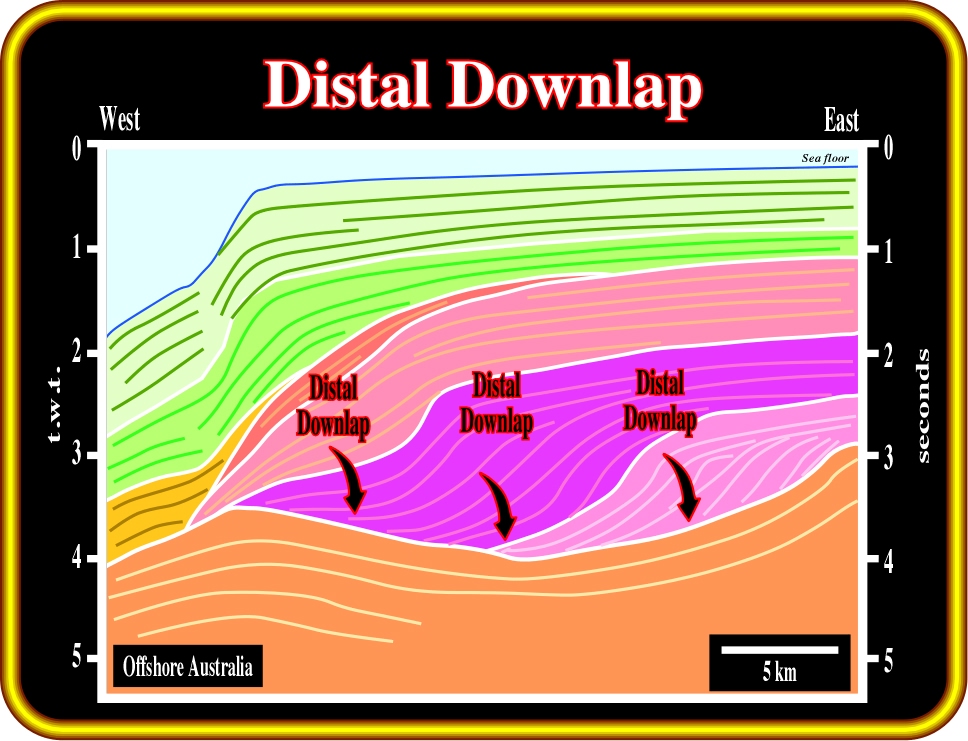
Plate 172 - In the upper stratigraphic levels of post-Pangea Atlantic-type divergent margins, progradational intervals are very common, as illustrated above. Such intervals have a forestepping geometry and distal downlaps, in other words, downlaps parallel to the clastic supply. Progradational intervals are generally associated with a falling global (eustatic) sea level . However, progradational sedimentary intervals take place during decreasing relative sea level rises, which globally form the eustatic falling. Indeed, when 10 m of relative sea level fall is followed by 7 m of relative sea level rise, then a fall of 12 m, a rise of 8 m, a fall of 15 m and a rise of 10, corresponds in total to a global falling of 12 m. So, forestepping units are deposited during successive decreasing relative sea level rises, in which coastal aggradation is progressively smaller and smaller.

Plate 173 - Distal downlaps, i.e. downlaps in the direction away from the source of the clastic supply, often indicate the direction of terrigeneous supply, as illustrated above (Cretaceous rift-type basin). In this particular example, some distal downlaps look like apparent downlaps (see later). The inclined reflections seem to not terminate downdip, but flatten and continue seaward. Such a seaward continuity of the reflections can be apparent. It can be induced by low resolution of the seismic data. Indeed, geological speaking, there is a sharp facies change between the dipping reflectors (slope shales) and the flat reflectors (turbidite sandstones). The mounded sedimentological anomalies are slightly disconnected from the toe of slope progradations.
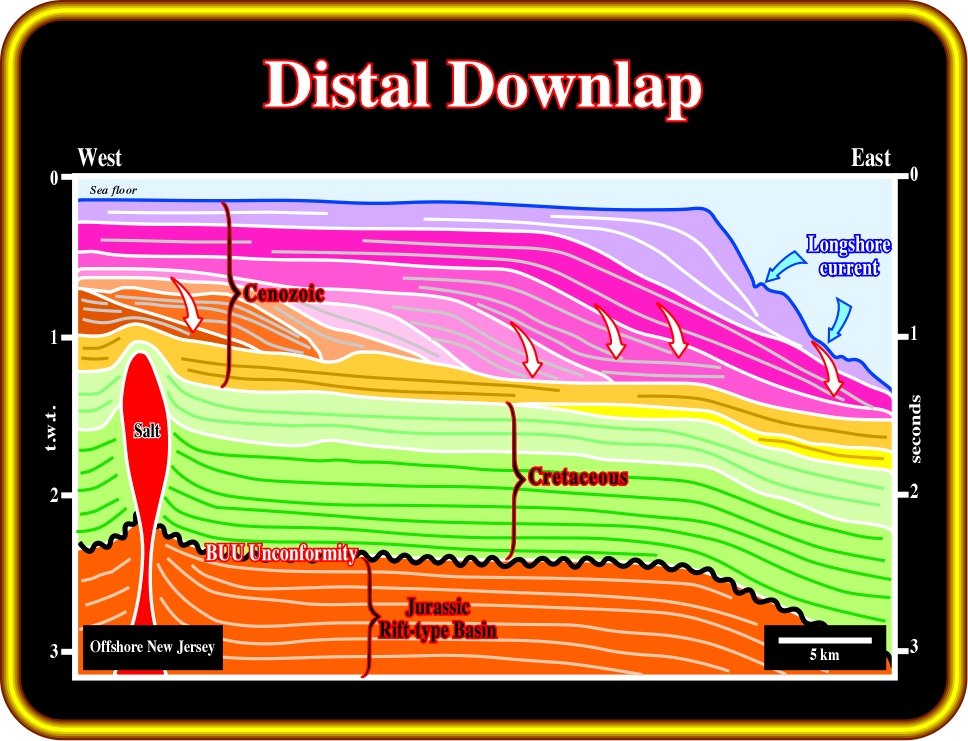
Plate 174 - On this line from Baltimore Canyon, distal downlaps are recognized in the Cenozoic progradational units, which genetically, are eustatically induced. Indeed, during the Cenozoic, tectonic subsidence was negligible. In spite of the strong activity of longshore currents, these distal downlaps clearly indicate terrigeneous influx coming from the west. Longshore currents, which generally are limited to the surf zone and formed by waves approaching the coast at an angle, eroded the upper slope (basin without platform) creating channel-like depressions parallel to the coastline. Later, these depressions were filled by lateral terrigeneous influx. The facies of such filled-depressions (contourites for some geologists) is shale free and full of heavy minerals.
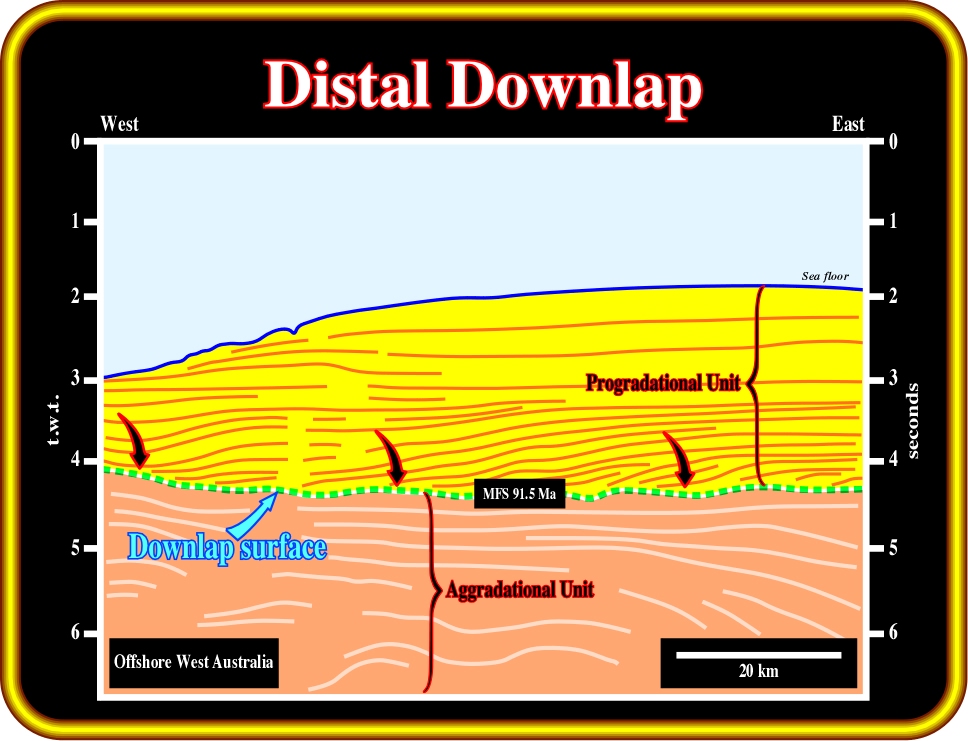
Plate 175 - Successive distal downlaps create a downlap seismic surface which is characterized by an increasing seaward time-gap (hiatus). Downlap surfaces are developed during eustatic highs, so they obey the same hierarchy as eustatic cycles. Downlap surfaces induced by 1st order eustatic cycles are often called major downlap surfaces. Since the Phanerozoic, there are two major downlap surfaces. Both separate the transgressive (backstepping) and regressive (forestepping) phases of the continental encroachment cycles (Paleozoic and Meso-Cenozoic cycles).

Plate 176 - On this seismic line, distal downlaps with opposite vergences define two significant downlap surfaces, which represent the closure of a sea, caused by the collision between two continents. The lower downlap surface, along which distal onlaps look southward, suggests a continent to the North, and a sea to the South. In contrary, the upper downlap surface suggests a sea to the North and a continent to the South. Subsequently, according to the Plate Tectonics paradigm, it is logical to hypothesize the closure of a sea as the continents collided.
(ii) False Downlap
False downlap is a downdip tangential stratal termination. Strata flatten and continue as units, which, often, are so thin that they fall below the seismic resolution.
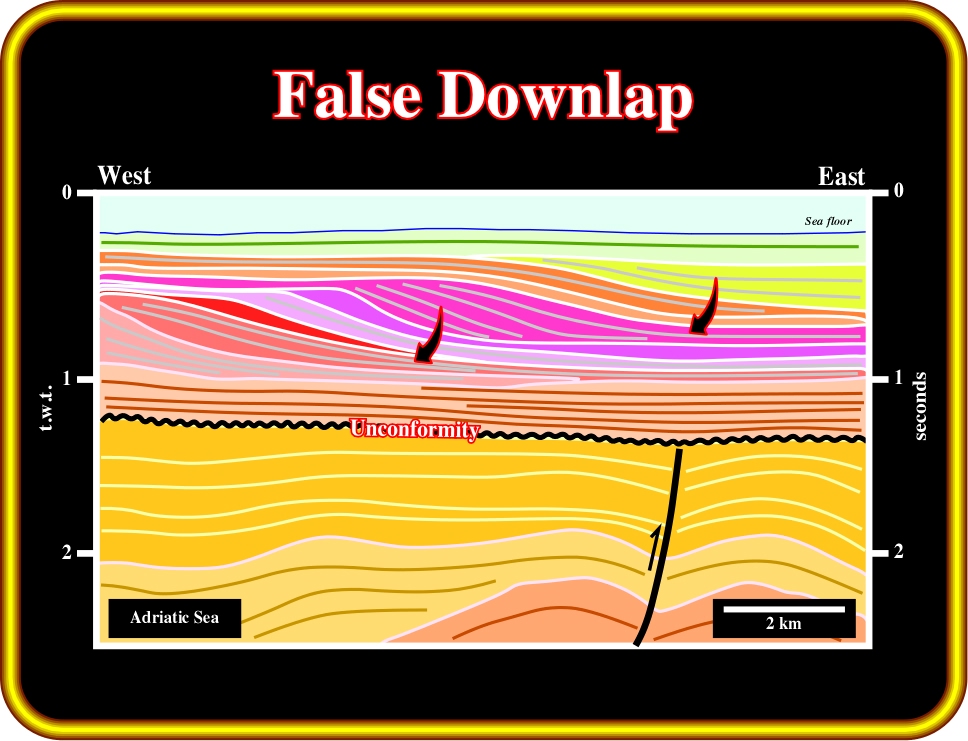
Plate 177 - As illustrated on this seismic line, in false downlap, the depositional oblique reflectors flatten downdip and continue seaward as sedimentary units, where their thickness can increase slightly. Before considering a downlap as a false downlap, interpreters must be sure that the tangential termination is not a consequence of low seismic resolution. If there is a sharp facies change between the oblique (shale) and subhorizontal (sand) segments, there is a downdip strata termination, and so it must be considered as a downlap.
(iii) Shelf Downlap
A shelf downlap is a downlap recognized in a shelf. Often, it underlies the slope of a depositional coastal break. The water depth is less than 200 meters (prodelta).

Plate 178 - Taking into account the vertical scale, it is evident that inclined seaward reflectors likely correspond to a deltaic slope. Indeed, the time-difference between the updip and downdip terminations is less than 200 milliseconds (two way time). Therefore, their downdip terminations can be considered as shelf downlap. Notice that within the progradational interval (deltaic environment), the relative sea level falls and/or the lateral shift of the deltaic lobes are denoted by subtle onlap surfaces.
(iv) Shelf Downlap
A slope downlap is a downlap associated with a continental slope. The water depth is higher than 200 meters.
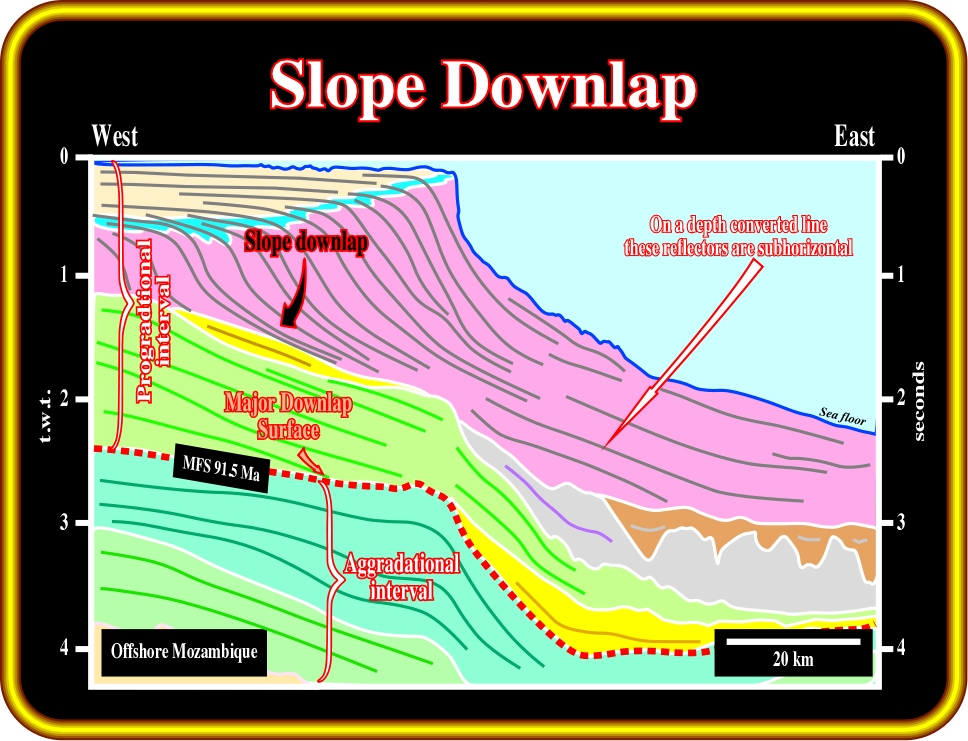
Plate 179 - Contrariwise to shelf downlaps (Plate 178), on this seismic line, the downlaps are slope downlaps, that is to say, the depositional inclined reflectors illustrate the successive morphologies of the continental slope. Take into account the pitfall induced by the abrupt change in the water depth. Indeed, in a depth converted line, the reflectors seaward of the present-day shelf break are subhorizontal or gently dipping seaward.
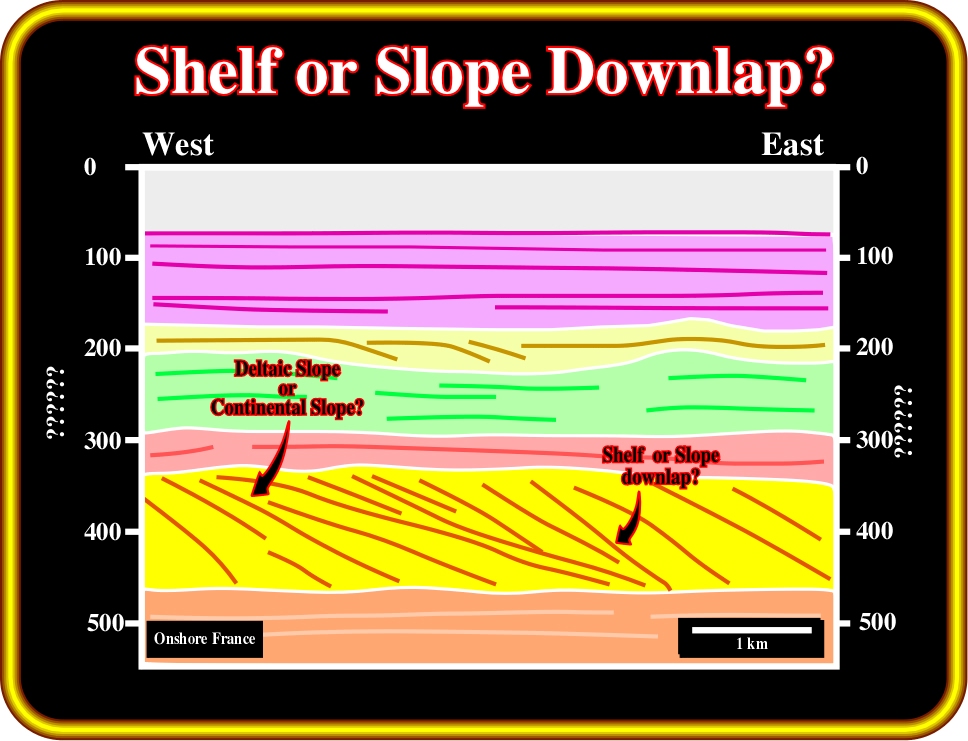
Plate 180 - On the two previous seismic lines, we could differentiate shelf downlaps associated with deltaic slopes, from slope downlaps associated with continental slopes, using the vertical and horizontal scales of the seismic lines. Geology is scale dependent and so seismic interpretation can only be correctly performed knowing the scales of the seismic data. For instance, interpreters will be unable to interpret the depositional inclined reflector illustrated above. It is obliged to make a guess: shelf or slope downlaps?
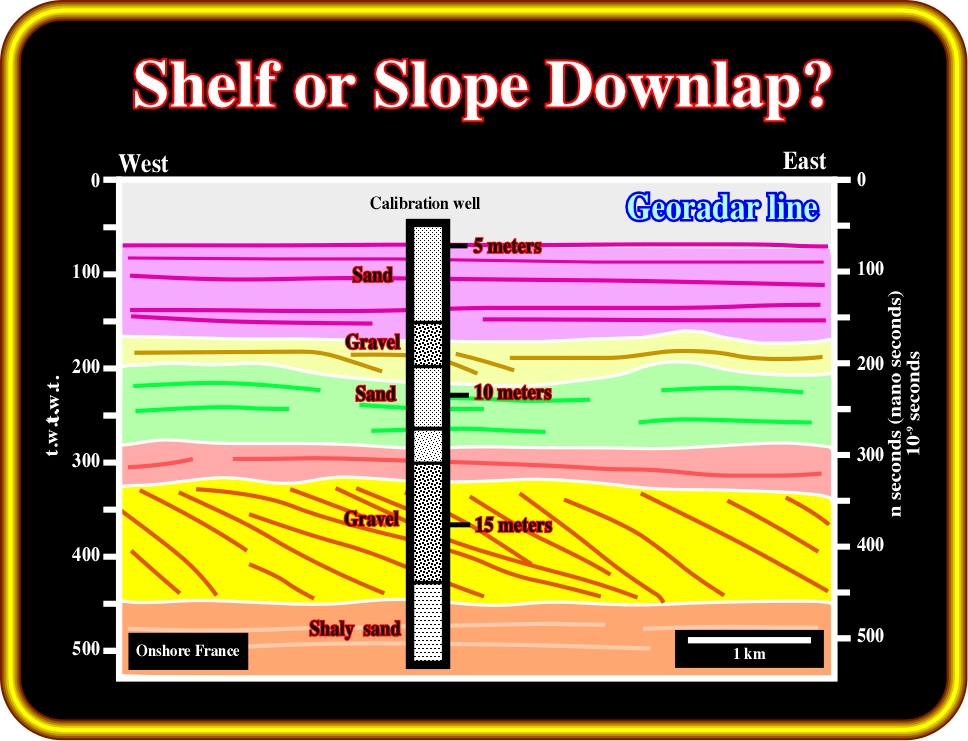
Plate 181 - The vertical scale of the previous line is in nanoseconds, that is to say, 10-9 seconds. In other words, the previous line is a georadar line shot in onshore France (Pin Sec). The proposed interpretation is based in a calibration well in which georadar velocities range from 8 ns in the shaly sands, to 13 ns in the gravel. Velocities of 15 ns were found in the upper sand interval. The depositional inclined reflectors are not associated with a deltaic or continental slope, but are rather small oblique bedding planes.
(v) Opposite Downlaps
Opposite downlaps are characteristics of overbank deposits, whether associated with fluvial or turbiditic levees
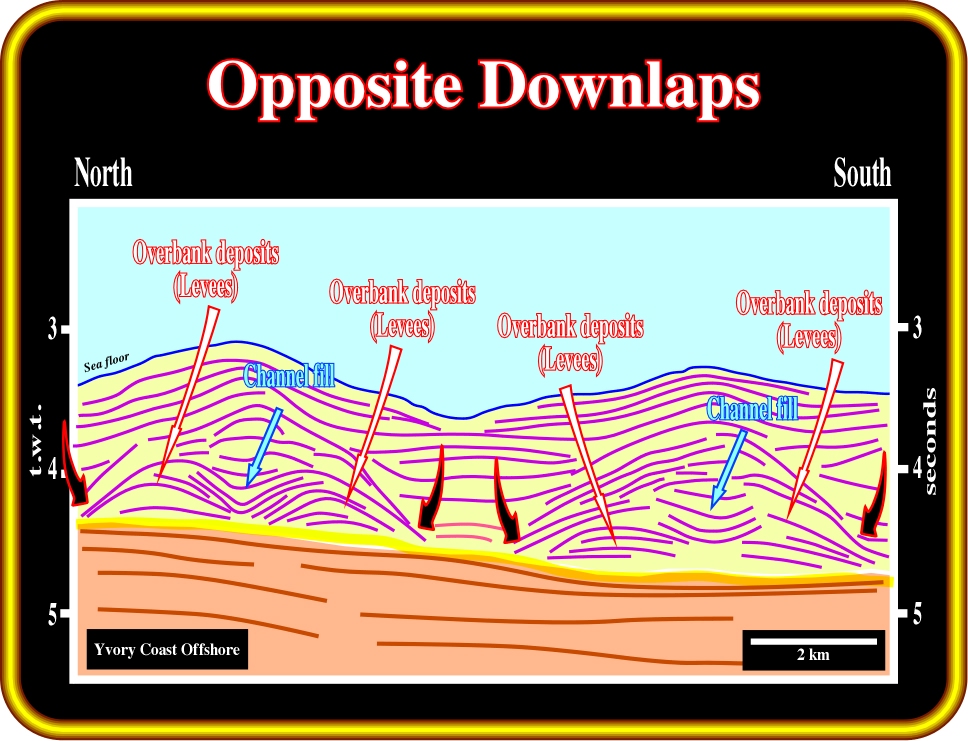
Plate 182 - On this line from the Ivory Coast deep-water, where turbidite channel-levees complexes (“gull wings” of P. Vail) are paramount, opposite downlaps are easily recognized in the overbank deposits. Admittedly, these downlaps cannot be considered as distal, since they do not indicate the direction of the source of the clastic supply. On the contrary, they indicate the local direction of the overbank currents, that is to say, local sediment transport-direction, which is away (roughly perpendicular) from the central troughs (often called “channels”).
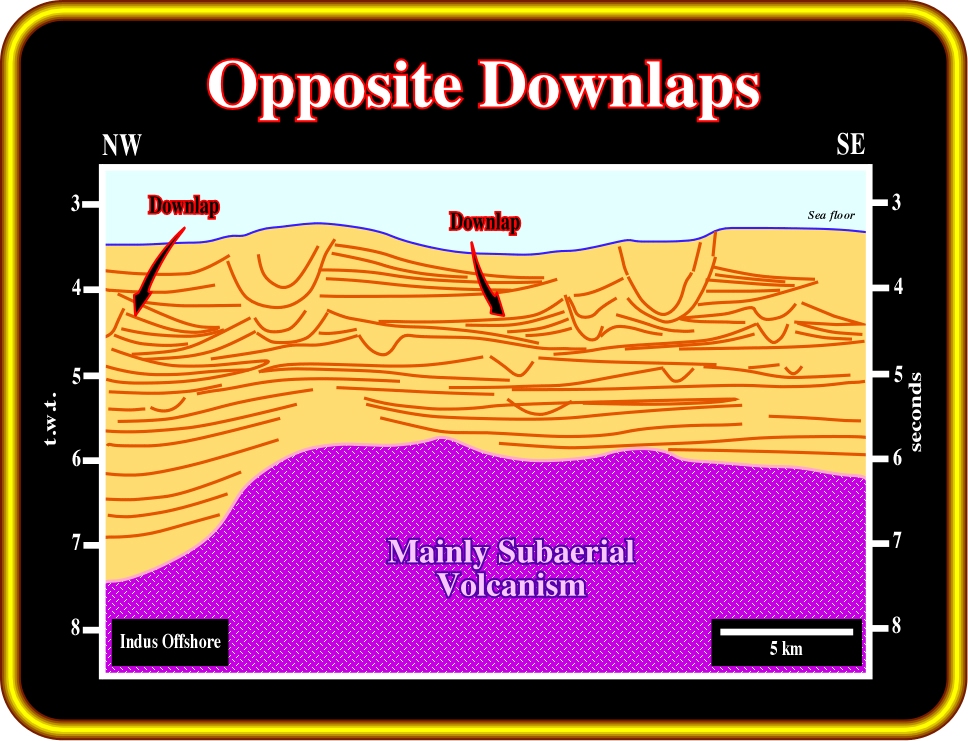
Plate 183 - In the seismic lines from Indus offshore, opposite downlaps are the preponderant reflection terminations. They are associated with turbidite slope depositional systems, particularly with channel-levees complexes, in association with the overbank deposits (turbiditic levees). As illustrated on this line, the seismic reflections can only be depositional. In other words, the observed dips are depositional and not tectonic dips (post-depositional). They cannot be explained by any known tectonic model. At present time, all geologists associate the “gully wings” of P. Vail with slope fan turbidites. However, in the 60's and 70's, the majority of exploration wells drilled for instance, in the Cameroon offshore (Matanda, Sulebaba, etc.), were supposed to test structural traps (four way dip closure), but, in fact, they tested mainly channel-levees complexes (“gull wings”), i.e., the opposite downlaps were considered as structural dips.
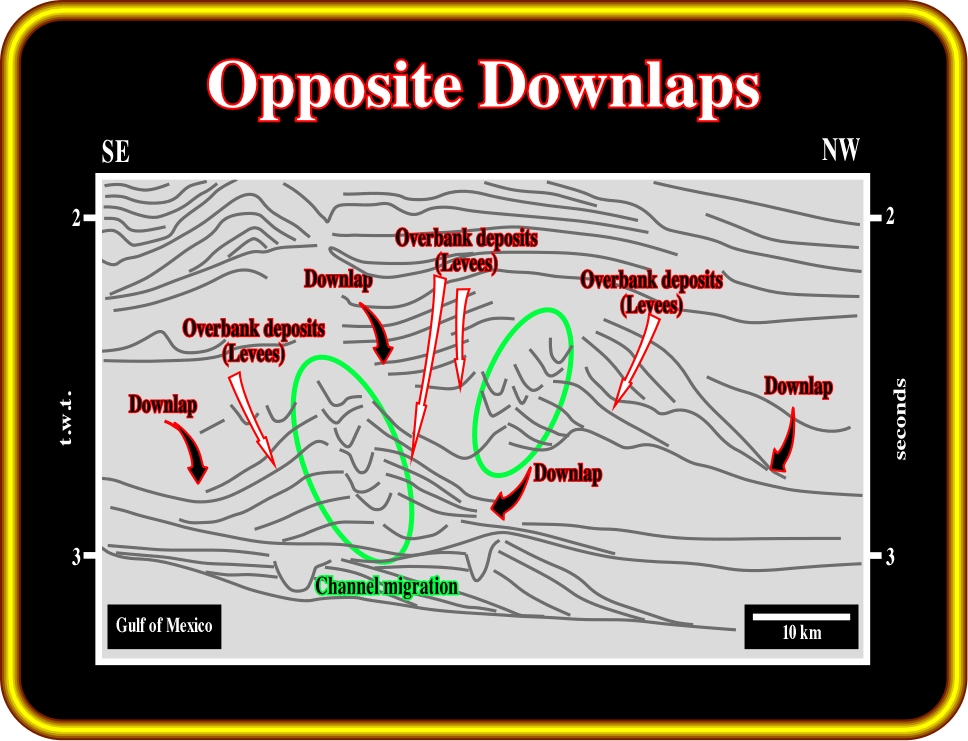
Plate 184 - Modern seismic lines, like this line from the Gulf of Mexico, show so many details that sometimes interpreters have difficulty recognizing the main characteristics of geological models. Indeed, on this line, the opposite downlaps associated with the deep-water turbidite channel-levees complexes are much more difficult to recognize than the migration of the turbidite channels. It is interesting to notice that, at least in this particular example, one cannot related the size (height) of the channel-levee complex with the height of the turbidite currents. Indeed, due to lateral and vertical migration of the channel, even a small gravity current cannot be contained within the channel and so it overbanks.
(vi) Apparent Downlap
Original onlap terminations when deformed by tectonics or halokinesis (salt tectonics) can become apparent downlaps.
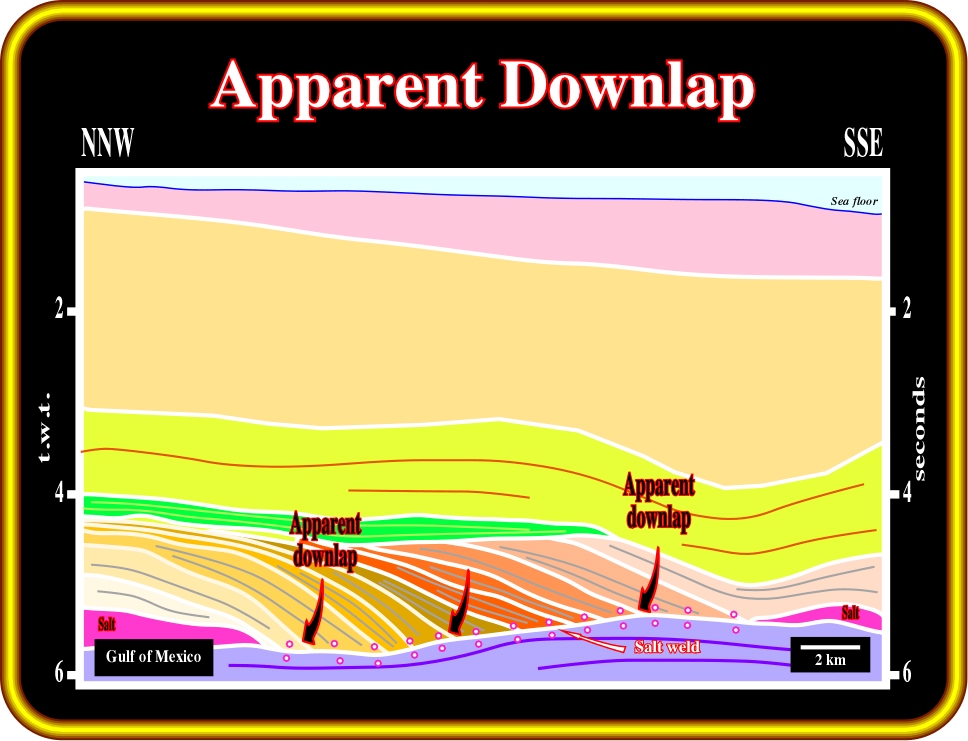
Plate 185 - The presence of autochthonous salt relics along the disconformity strongly suggests the reflection terminations against it are apparent downlaps, i.e., original onlaps tilted seaward as the salt flowed laterally. Actually, these oblique reflections cannot be interpreted as progradations, since they thick towards the décollement plane (salt-induced tectonic disharmony). It is interesting to point out that in 1986, arriving in Houston from Luanda (where halokinesis was well known), using this seismic line, I spent several hours explaining to the godfathers of Petroleum Geology that these reflectors should not be interpreted as Cretaceous continental slope progradations.